There are four venomous snake species in Illinois. They are the Eastern Copperhead, the Northern Cottonmouth, the Timber Rattlesnake, and the Eastern Massasauga.
Each of these snakes contributes to the health of the Illinois environment by keeping rodent populations under control. Each of these snakes is potentially dangerous, though. In fact, in an average year, 35 people are bitten by venomous snakes in Illinois.
Anyone who spends time in Illinois outdoors should know where these dangerous snakes live, how to identify them, and how to stay safe in their domain.
In this comprehensive guide, we’ll tell you where in Illinois these dangerous snakes live. We’ll also tell you how to identify them and how to avoid potentially life-threatening venomous snake encounters.
Pit Vipers: The Venomous Masters of Infrared Detection
Rattlesnakes, Copperheads, and Cottonmouths are among the most well-known members of the venomous Crotalinae subfamily, also referred to as pit vipers. These snakes are equipped with unique adaptations that make them exceptional hunters.
What Makes Pit Vipers Unique?
- Infrared-Sensing Pits:
A defining feature of pit vipers is the deep facial pit between their nostril and the eye on each side of their head. These specialized infrared-detecting organs allow pit vipers to sense heat emitted by prey. This adaptation enables them to:- Detect body heat from up to 1 meter away.
- Strike prey with pinpoint accuracy, even in complete darkness.
- Triangular Heads and Vertical Pupils:
- Head Shape: Pit vipers are recognized by their distinct triangular-shaped heads, which house their venom glands.
- Eyes: They have vertical elliptical-shaped pupils.
- Venomous Fangs:
Pit vipers have hollow fangs connected to venom glands. These fangs fold back against the roof of their mouth when not in use.
Ecological Importance
Pit vipers play a crucial role in maintaining ecosystem balance by controlling rodent populations. Despite their fearsome reputation, these snakes are vital to the health of many habitats.
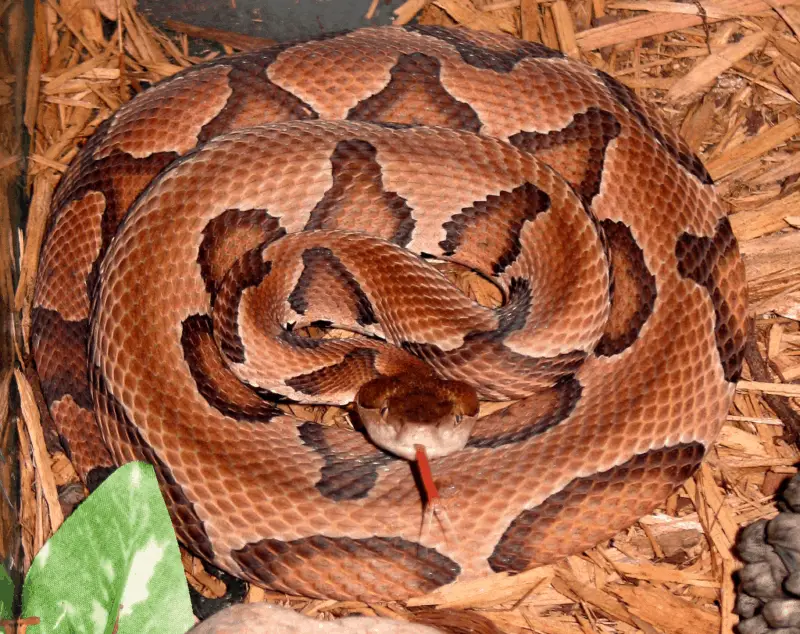
Eastern Copperhead (Agkistrodon contortrix)
The Eastern Copperhead is a pit viper native to the eastern United States.
What Do Eastern Copperheads Look Like?
| Coloration | *Reddish-tan to grayish-tan bodies. *Overlaid with dark brown, hourglass-shaped markings. *Heads are dark coppery brown, giving them the name “Copperhead.” |
| Body Shape | *Stout and heavy-bodied snakes. *As with all pitvipers, their heads are triangular and appear oversized in relation to their necks. |
| Size | *Adults range from 20 to 37 inches (50 to 95 cm) in length. |
| Conservation Status | Common and native to the southern third of Illinois. |
Taxonomy of Illinois’ Eastern Copperhead Snakes
Copperhead snakes are found in the southern third of Illinois and are now recognized as a single species: the Eastern Copperhead (Agkistrodon contortrix).
In the past, these snakes were classified into different subspecies, including the Northern Copperhead, Southern Copperhead, and Osage Copperhead. However, recent DNA studies revealed minimal genetic differences between them. As a result, these subspecies were combined into a single taxonomic group under the Eastern Copperhead name.
Where Do Eastern Copperheads Live in Illinois?
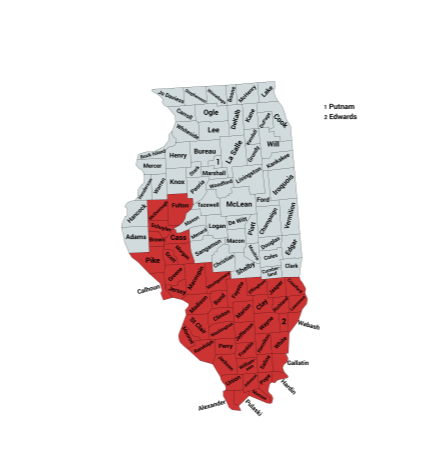
Eastern Copperheads are found in the southern third of Illinois. They are found in deciduous forests, river bottoms, and rocky wooded hillsides.
Eastern Copperhead Behavior
Copperheads are dangerous because they use camouflage as their number one defense mechanism. In other words, these snakes choose to lie perfectly still rather than flee most of the time. Their camouflage helps them blend in with leaf litter and other ground debris.
When they feel threatened, they occasionally mimic the tail vibration of a rattlesnake. But, in most cases, they choose to lie perfectly still.
Most copperhead bites on humans occur when the person steps on or near the snake.
What Do Copperheads Eat?
Copperhead snakes are opportunistic feeders. They eat insects, spiders, frogs, small animals, birds, and other reptiles.
How Dangerous Are Copperheads?
A Copperhead can bite and inject venom from the time they are newly born. Like most pit vipers, they have hemotoxic venom.
Most copperhead bites are not life-threatening. On the other hand, any bite from this snake is a medical emergency and should be treated as such. Prompt medical attention increases the chance of a good outcome.
Copperhead bites can cause intense pain, shock, and swelling. Their bites also have the potential to cause blood in urine, tissue damage, and kidney failure.
An interesting study has found that Copperhead venom contains a protein called contortrostatin. Contortrostatin has been found to stop the growth of cancer cells in mice.
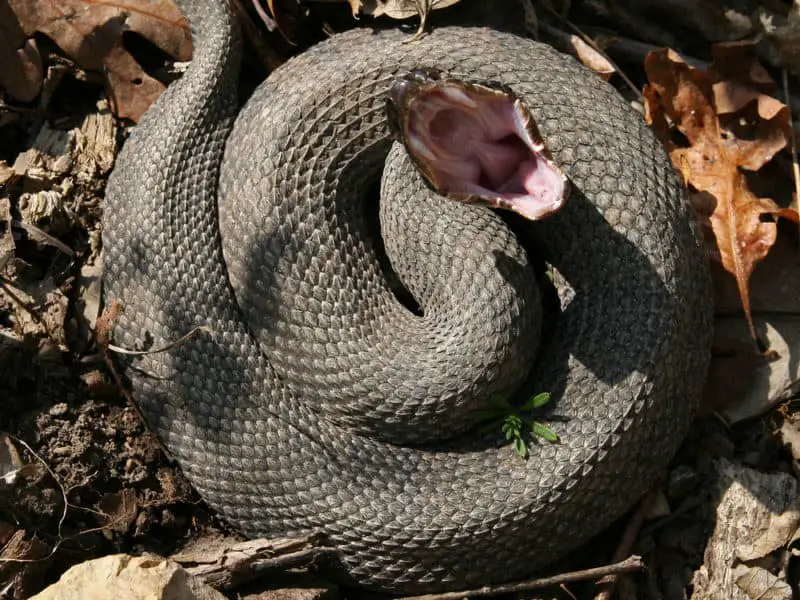
Northern Cottonmouth (Agkistrodon piscivorus)
Another common name for the Northern Cottonmouth snake is water moccasin. These are stout, muscular snakes that grow up to 3 feet (.91m) long. They look a little bit like rattlesnakes without the rattle on the tail. People also sometimes mistake them for common water snakes. This could be a dangerous mistake.
What Do Northern Cottonmouths Look Like?
| Coloration | *Adults: Dark brown to black body with minimal markings. *Inside of the mouth: White, giving them the name “cottonmouth.” *Juveniles: More defined patterns, resembling a copperhead with darker bands that widen toward the belly and narrow along the back. *Inside is pale pink to white, visible during their defensive open-mouthed pose (origin of the name “cottonmouth”). |
| Body Shape | *Stout, muscular snakes. |
| Size | *These snakes grow up to 3 feet (0.91 m) in length. |
| Behaviors | *Cottonmouths arc their heads upward and display an open-mouthed pose when agitated. This exposes the white interior of their mouth. This is a warning to back off or suffer the consequences. *Interestingly, they can hold their breath underwater for up to an hour while hunting for prey. |
| Distinctive Features | *Pupils are cat-like and elliptical, appearing as narrow slits during the day. At night, pupils appear round. |
| Conservation Status | Common and native to southern Illinois. |
Where Do Northern Cottonmouths Live in Illinois?
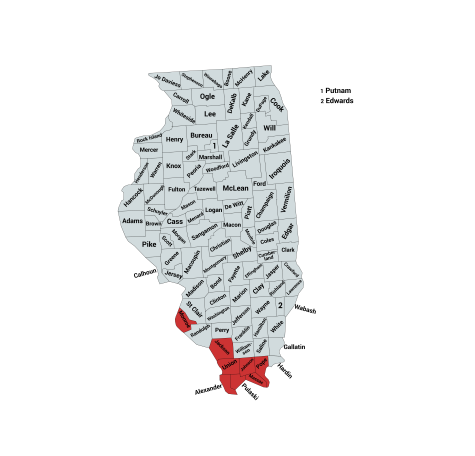
Cottonmouths are found in southern Illinois. They are one of the three venomous species of snakes in the Shawnee National Forest.
They are semi-aquatic snakes. They favor wet habitats such as swamps, drainage ditches, slow-moving rivers, and lakes. They commonly sun themselves on rocks or logs at the water’s edge. Cottonmouths sometimes venture overland. It’s not unheard of to see one far from any aquatic environment.
What Do Northern Cottonmouths Eat?
These snakes prey on fish, freshwater crustaceans, amphibians, small mammals, and other reptiles. Cottonmouths sometimes congregate around drying wetland pools to feed on any trapped fish.
How Dangerous Are Northern Cottonmouths?
Cottonmouth snake venom is cytotoxic. This means it destroys body tissue. Northern Cottonmouth bites sometimes lead to the amputation of limbs. On rare occasions, death can occur.
Rattlesnakes of Illinois
Illinois is home to two rattlesnake species, the Timber Rattlesnake and the Eastern Massasauga,
Rattlesnakes are pit vipers. See the description of pit vipers above.
What Illinois rattlesnakes have in common with most other rattlesnake species is their rattle.
- Most rattlesnakes have a rattle at their tail’s end, comprised of hollow, loosely interlocked keratinous scales.
- Normally, a rattlesnake adds a new segment to its rattle each time it sheds its skin.
- An agitated rattlesnake rapidly vibrates its tail, causing the segments of its rattle to vibrate together, creating a buzzing or rattling sound.
- Not all Illinois rattlesnakes rattle before they strike. Sometimes, they lose their rattles due to injury, and sometimes, they choose not to rattle.
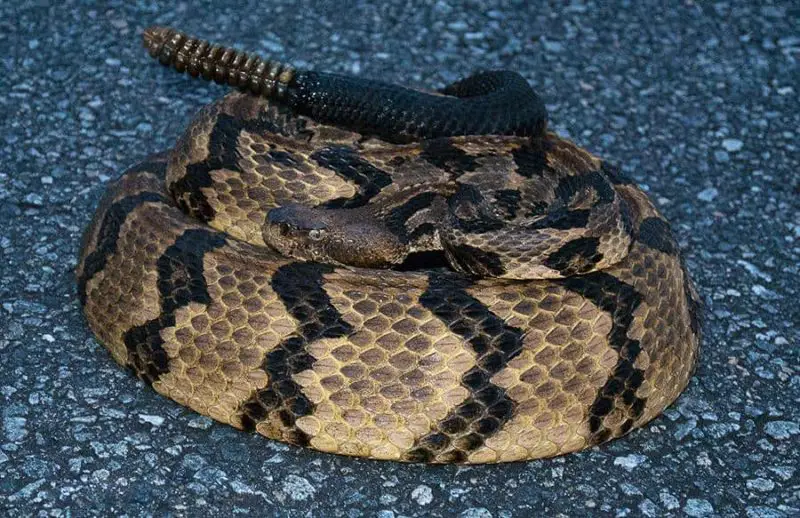
Timber Rattlesnake (Crotalus horridus)
Timber Rattler and Canebrake Rattlesnake are both common names for the Timber Rattlesnake. Generally, in higher-elevation habitats, they are called Timber Rattlesnakes. On the coastal plain, though, they’re called Canebrake Rattlesnakes.
What Do Timber Rattlesnakes Look Like?
| Size | *Average length: 36 to 60 inches (0.91 to 1.52 m). *Rare cases reported: Up to 7 feet (2.13 m). |
| Coloration | *General base color: Yellowish-brown to grey-brown. *Chevron pattern: Dark brown to black chevrons on their back and sides against a lighter base color. *Back stripe: Rusty to reddish stripe running down their back. *Tail color: Dark brown or black. |
| Melanistic Variation | *Some timber rattlesnakes exhibit a dark, melanistic color morph. *These snakes can appear almost entirely black. *The tail is darker than the rest of the body in this morph. |
| Behaviors | *These snakes are excellent climbers. In fact, timber rattlers have been found in trees at heights of more than 80 feet. *The experts have proven that timber rattlesnakes help control Lyme disease. This is because as they consume rodents, they’re also consuming ticks. A timber rattler will consume 2,500 to 4,500 ticks per year, depending on the location. |
| Conservation Status | Timber rattlesnakes are listed as threatened in Illinois. |
Where Do Timber Rattlesnakes Live in Illinois?
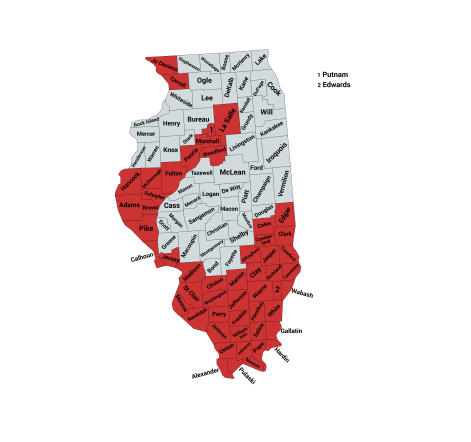
Timber Rattlesnakes live in southern, west-central, and northwestern Illinois. Source The timbered bluffs overlooking the Mississippi River are Timber Rattlesnake habitat. They also live in the Shawnee National Forest.
Timber rattlesnakes are a threatened species in the state of Illinois. Their downfall is mainly habitat loss. But indiscriminate killing is also a factor.
What Do Timber Rattlesnakes Eat?
Timber rattlers prey on small mammals such as mice, rats, squirrels, and chipmunks. They also eat small birds, other reptiles, and amphibians.
How Dangerous Are Timber Rattlesnakes?
Timber Rattlesnakes are among the most dangerous snakes in North America. This is due to their long fangs and high venom yield. 1% to 10% of untreated Timber Rattlesnake bites result in a fatality.
Fortunately, 40% to 60% of the time, they produce dry bites. In other words, although their fangs penetrate the body, they do not inject any venom.
These snakes produce hemotoxic venom. Timber Rattlesnake bites sometimes cause serious complications. These include shock, seizures, coma, internal bleeding, and deep tissue damage.
Scorpions in Illinois – Krebs Creek
Wild Cats in Illinois – Krebs Creek
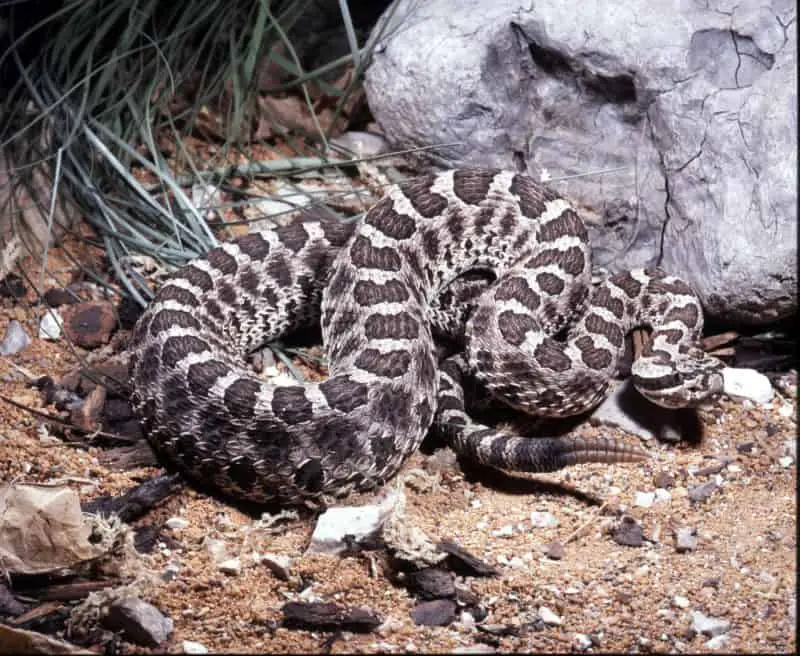
Eastern Massasauga Rattlesnakes (Sistrurus catenatus)
Massasaugas have a high-pitched rattle sound, which is different from other rattlesnakes. This is why they have the nickname Buzztail.
| Size | *Adult Eastern Massasaugas average 22 to 30 inches (55 to 75cm) long. |
| Coloration | *Their base color is light grey. *Some melanistic snakes are almost entirely black in color. |
| Dorsal Spots | *A row of large, rounded, blackish-brown spots run down their spine. *They have three smaller rows of spots down each side. *In some cases, the larger dorsal spots connect with the side spots, forming a large solid blotch. |
| Head | *A dark stripe on each side of their face and across their eye. |
| Conservation Status | *Eastern Massasaugas are endangered in Illinois. |
Where Do Eastern Massasauga Rattlesnakes Live in Illinois?
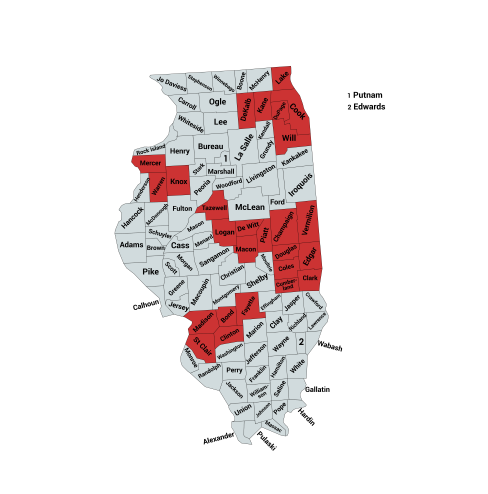
Eastern Massasaugas live in forested swamplands, marshy grasslands, lake edges, wet prairies, and woodlands.
Eastern Massasaugas are endangered in Illinois. The Illinois Department of Natural Resources has this to say on the subject. “The endangered status of the eastern Massasauga is mainly due to habitat loss.” Drainage of prairie marshes has destroyed most of their former habitat in Illinois. Today, there are less than ten known Massasauga populations in the state.
What Do Eastern Massasauga Rattlesnakes Eat?
Eastern Massasaugas prey on smaller rodents such as mice and voles. They also eat frogs, toads, and small snakes.
How Dangerous Are Eastern Massasauga Rattlesnakes?
The venom of the Massasauga rattlesnake is cytotoxic. Cytotoxic venom destroys body tissue. Moreover, digestive enzymes in cytotoxic venom disrupt blood flow and prevent clotting. Massasauga bites to humans are rare. However, they do occur.
There are two documented deaths in Ontario from Eastern Massasauga envenomations. In each case, the victim did not receive antivenom in time.
Illinois’ Venomous Snakes in Winter: Insights into Brumation
During winter, Illinois’ snakes, like all reptiles, enter a dormant state called brumation—a hibernation-like period. Because snakes are ectothermic (cold-blooded) and cannot regulate their body temperature internally, they slow their metabolism and become inactive during the colder months.
Brumation Habits
- Solo vs. Communal Brumation: Some snakes brumate alone, while others gather in communal dens. For example, Eastern Copperheads and Timber Rattlesnakes often share dens, which may house up to 60 snakes.
- Mixed-Species Dens: Interestingly, these dens can include non-venomous species. It’s common to find Black Rat Snakes or Eastern Black Racers sheltering alongside venomous snakes.
Regional Variations
- Snakes may only seek shelter in warmer areas on the coldest winter days. They might not enter full brumation due to milder conditions.
Where Snakes Spend Winter
Snakes seek out protected spots to brumate, such as:
- Rock crevices
- Hollow logs
- Fissures on rocky hillsides
They often choose south-facing slopes because these areas receive more sunlight, providing additional warmth during winter.
This natural adaptation allows Illinois’ venomous snakes to survive the winter and re-emerge when temperatures rise.
Avoiding Snake Bite
Eastern Copperheads are the species responsible for the most venomous snake bites in Illinois. These snakes rely on their excellent camouflage to stay hidden. They often remain perfectly still to avoid detection. If you’re walking in the woods and unknowingly get too close, a copperhead might not move, hoping you’ll pass by. Many bites happen when someone accidentally steps on the snake. To stay safe in snake habitats, always watch where you step and where you place your hands.
Another common cause of snake bite is attempts to capture or kill a snake. Remember, venomous snakes can strike instantly, delivering a potentially life-threatening bite. The safest approach is to keep a safe distance and leave them alone.
Dressing for Snake Country
- High-top leather boots and long pants are both wise ideas.
- Also, wear loose-fitting denim. If there’s a gap before the snake’s fangs touch your skin, your chances of being envenomated are lower.
- In the absence of high-top leather boots, some people wear snake gaiters.
Symptoms of Venomous Snake Bites
Some of the symptoms you may experience when a venomous snake bites you include:
- Discoloration in the area of the bite.
- Swelling in the area of the bite.
- Loss of muscle coordination.
- Tingling sensation in the area of the bite.
- Feeling nauseous.
- Having a faster heartbeat or rapid pulse.
What Should You Do if You Are Bitten?
If you or someone you are with has suffered a venomous snakebite, time is of the essence. Because the sooner a victim receives antivenom, the less chance the venom in their body has to cause harm. In other words, it is crucial to seek immediate medical treatment.
Do not attempt to kill the snake for identification purposes. This gives the snake a chance to bite you again. Also, consider that severed snakeheads can still bite and envenomate and often do. If you have a phone, take a picture of the offending reptile. Otherwise, get started on your way to the nearest hospital.
First Aid for Snake Bite Victims
- Remain calm and limit your movements. Do not run. If you must hike back to a vehicle, do it calmly and deliberately. Put as little stress on your heart as possible.
- Keep the area of the snake bite below the heart level and never above the heart level. Keeping the bite below the heart level will reduce the venom’s flow. However, holding the bite above your heart level will increase the venom’s flow.
- Remove all constricting items such as bracelets, watches, or rings before swelling occurs.
- Remember that using a cold compress on a venomous snake bite is not advisable. The cold may cause the local blood vessels to constrict and spread the venom faster.
- You can wash the affected area like any other wound with soap and water.
- You may cover the bite area with a moist dressing to reduce the swelling.
- Get medical attention as soon as possible. Call the hospital to tell them a venomous snake has bitten you so they can have antivenom ready to give you when you arrive.
- A person whom a venomous snake has bitten may go into shock. If this happens, lay them flat and cover them with a blanket.
Snake Road
Forest Road # 345 in Illinois’ Shawnee National Forest is world-famous. It is nicknamed the Snake Road. This is because the 2.5-mile road is closed to vehicles twice yearly to allow for snake migration.
The Forest Service closes the road from March 15 to May 15 to allow reptiles to migrate west into LaRue Swamp. The snakes have spent the winter denning in limestone cliffs east of the road. The road is closed again from September 1 to October 30. This allows the resident snakes to go from the swamp back to the cliffs.
Several species of non-venomous snakes make the biannual migration. You might also see Copperheads, Timber rattlesnakes, or Cottonmouths on the snake road.
Conclusion
Illinois’ venomous snakes, including the Eastern Copperhead, Northern Cottonmouth, Timber Rattlesnake, and Eastern Massasauga, play vital roles in their ecosystems by keeping rodent populations in check.
These snakes are also dangerous to humans. In an average year, around 35 people are bitten by venomous snakes in Illinois.
Anyone exploring the outdoors in Illinois, including the Shawnee National Forest’s iconic “Snake Road”, should exercise appropriate caution. This includes knowing where these dangerous reptiles live. You should also pay close attention to where you place your feet and hands in venomous snake country. Finally, wearing appropriate clothing will make you a little safer from snakebite.
Recent Posts
The only venomous snakes in Washington State are Northern Pacific Rattlesnakes. The Northern Pacific Rattlesnake (Crotalus oreganus oreganus) is a sub-species of the Western Rattlesnake. Anyone...
Skunks are not classified as true hibernators. But they go into a state of torpor when the weather gets cold. Skunks are light sleep hibernators, along with opossums, bears, and raccoons. ...
